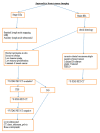The Role of PET/CT in Breast Cancer
- PMID: 36832085
- PMCID: PMC9955497
- DOI: 10.3390/diagnostics13040597
The Role of PET/CT in Breast Cancer
Abstract
Female breast cancer has surpassed lung cancer as the most commonly diagnosed cancer worldwide, with an estimated 2.3 million new cases (11.7%), followed by lung cancer (11.4%) The current literature and the National Comprehensive Cancer Network (NCCN) guidelines state that 18F-FDG PET/CT is not routine for early diagnosis of breast cancer, and rather PET/CT scanning should be performed for patients with stage III disease or when conventional staging studies yield non-diagnostic or suspicious results because this modality has been shown to upstage patients compared to conventional imaging and thus has an impact on disease management and prognosis. Furthermore, with the growing interest in precision therapy in breast cancer, numerous novel radiopharmaceuticals have been developed that target tumor biology and have the potential to non-invasively guide the most appropriate targeted therapy. This review discusses the role of 18F-FDG PET and other PET tracers beyond FDG in breast cancer imaging.
Keywords: PET; breast cancer.
Conflict of interest statement
The authors declare no conflict of interest.
Figures






References
Publication types
LinkOut - more resources
Full Text Sources

